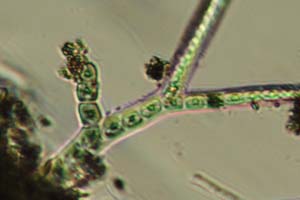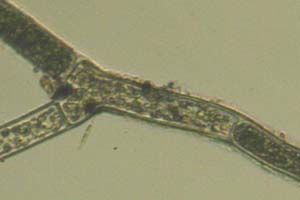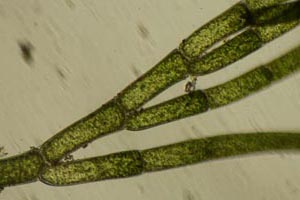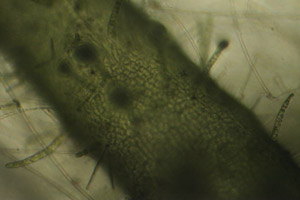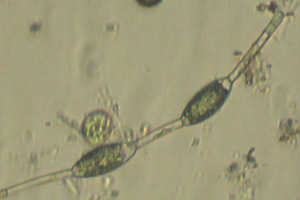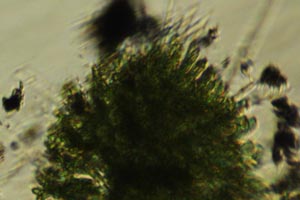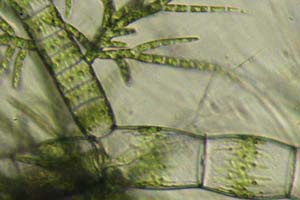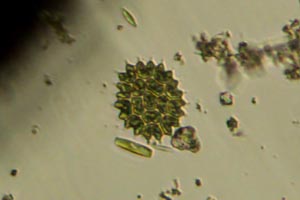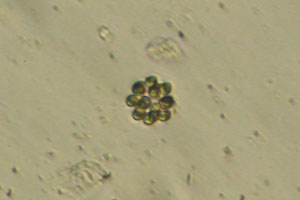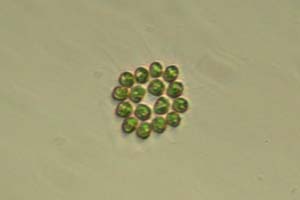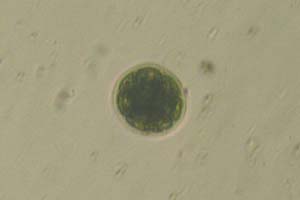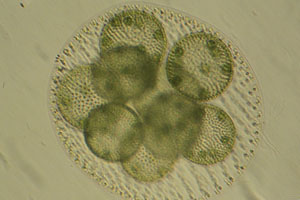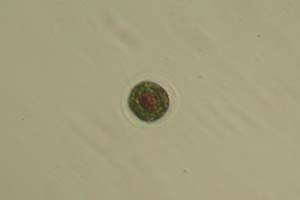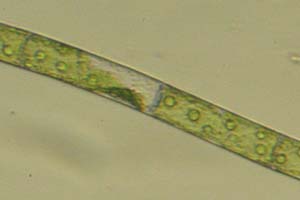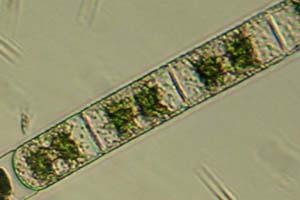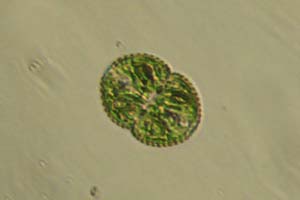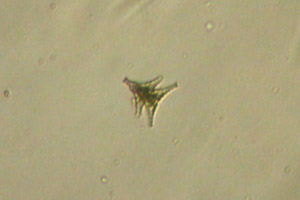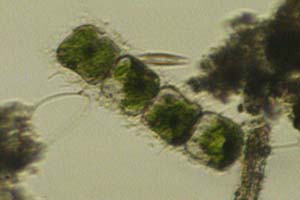Along with terrestrial forms like trees, shrubs, and herbs, plants also include some simpler algae. The cells of all sorts characteristically contain plastids, originally derived from cyanobacteria. These usually take the form of chloroplasts, coloured bodies that conduct photosynthesis and release oxygen.
Other algae have chloroplasts derived from those of plants, and have often developed into similar forms. In true plants the plastids occur free in the cell, with only two membranes, and are usually reddish or green. Most also have cell walls that maintain their shape, and tend to be non-motile, though many simpler kinds are exceptions.
Red algae are mainly marine. The chloroplasts are usually red in kinds from deep water, but in those from coasts or freshwater they are often greenish to bluish, or darker brown. In a few they contain round pyrenoids where starch is formed, but most lack them.
No flagella occur in the group. They generally live on rocks or other surfaces, relying on currents to distribute spores and gametes. The simplest kinds are microscopic cells, colonies, and filaments, but others are more complex seaweeds up to two metres in size.
Chroodactylon
Greek chrōs, colour, daktylos, finger
Angl. KROH-o-DAK-ti-lon
Chroodactylon form branching colonies on other algae, with strings of cells in gelatinous tubes. Each has a faint greenish chloroplast with a more noticeable pyrenoid.
Green algae occur in many aquatic habitats, especially freshwater. In most the chloroplasts are actually bright green and have one or more pyrenoids. They include single cells, cell colonies, simple filaments, and more complex types like stoneworts, and are ancestral to the terrestrial plants.
Some green algae are flagellates, and many others have flagellate gametes or spores. These typically have two or more anterior flagella, which move in coordinated strokes, and often have an eyespot in the chloroplast. Their structure is one of the main differences between classes.
Ulvophyceae are mainly filaments, sheets of cells, or various multi-nucleate forms, and include most marine green algae. Motile cells have flagella projecting out from slightly overlapped bases, each on the right side of the other, or sometimes many in a ring.
Rhizoclonium
Greek riza, root, klōnion, twig
Angl. RYE-zo-KLOH-neeum
Rhizoclonium form attached or floating filaments, sometimes with sparse branches. The cells are usually many times longer than wide, with net-like chloroplasts and multiple nuclei.
Cladophora
Greek klados, branch, phoros, bearing
Angl. kla-DOF-or-a
Cladophora filaments branch in a simple tree-like pattern. The cells are all similar in size, with net-like chloroplasts, and the terminal ends are simply rounded.
Ulva
Latin ulva, sedge
Angl. UL-va
Ulva grow as visible tubes with a single layer of cells, some also with filamentous branchlets. Many marine kinds develop further to form flat double-layered sheets.
Chlorophyceae include single cells, colonies, and palmelloid forms, all variously with or without flagella, as well as some filamentous groups. Motile cells have flagella projecting out from slightly separated bases, either directly apart or on the left side of one another.
Bulbochaete
Latin bulbus, bulb, Greek chaitē, long hair
Angl. BUL-bo-KEE-tee
Bulbochaete take the form of branched filaments with peculiar cells modified into long hairs or setae. These each have a bulbous base where they attach to the other cells.
Oedogonium
Greek oidos, swelling, gonos, offspring
Angl. EE-do-GOH-neeum
Oedogonium are simple filaments of cells that are often slightly enlarged and scarred at one end. When mature some swell up to form the female gametes.
Chaetophora
Greek chaitē, long hair, phoros, bearing
Angl. kee-TOF-or-a
Chaetophora grow as branched filaments in firm mucilage, radiating out from a central axis. The overall shape is elongate and usually itself branched and tree-like.
Draparnaldia
After Jacques Draparnaud, 1772-1804
Angl. DRAP-ar-NAL-deea
Draparnaldia are filamentous with larger cells in main axes and smaller ones in side branches. The latter often have long bristles and produce the reproductive cells.
Stauridium
Greek stauros, cross, -idion, dimn.
Angl. stawr-ID-eeum
Stauridium are flat colonies with four or sometimes more cells. These lack flagella and each have a distinctive outward-facing notch, even when surrounded by others.
Pseudopediastrum
Greek pseudēs, false, pedion, plain, astron, star
Angl. SOO-do-PED-ee-AS-trum
Pseudopediastrum are disc-shaped colonies without flagella. The cells are arranged in rings, usually with no spaces, and each outer one has two spine-like projections.
Coelastrum
Greek koilos, hollow, astron, star
Angl. see-LAS-trum
Coelastrum form hollow spherical colonies of oval to polygonal cells. Each is closely connected to its neighbours without any common sheath or flagella.
Gonium
Greek gōnia, angle
Angl. GOH-neeum
Gonium are flat colonies, most often with 16 cells. These all have flagella on the same side, giving them a slow tumbling motion, and in division each become a new colony.
Pandorina
After Pandōra of Greek myth
Angl. PAN-do-RYE-na
Pandorina are ovoid colonies of 8 or 16 flagellate cells crowded together in a gelatinous sheath. These are all similar, but they swim with a distinct front and back end.
Volvox
Latin volvere, to roll
Angl. VOL-voks
Volvox are hollow spheres with hundreds of cells, though only a few are reproductive. New colonies grow inside the parent until it breaks apart to release them.
Haematococcus
Greek haima, blood, kokkos, grain
Angl. HEE-ma-to-KOK-us
Haematococcus are flagellates with a halo-like cell wall, separated from the body by mucilage. The name comes from red pigments at the centre of or spread through the cell.
These flourish in clean, ephemeral water with little competition. Often most are non-motile resting cells, common as reddish slime in standing rainwater and bird baths.
Conjugatophyceae live exclusively in freshwater and lack flagella at all stages. Instead of releasing gametes, sexual reproduction characteristically involves direct fusion through a conjugating tube. There are two main groups; the first have continuous cell walls and are usually filamentous.
Mougeotia
After Jean Mougeot, 1776-1858
Angl. MOO-jee-OH-sheea
Mougeotia have one strip-shaped chloroplast running the length of each cell. These are able to rotate, facing dim but turning away from bright light.
Zygnema
Greek zygon, yoke, nēma, thread
Angl. zig-NEE-ma
Zygnema cells have two star-shaped chloroplasts, each with a central pyrenoid. In some the filaments also have a noticeable sheath.
Spirogyra
Greek speira, coil, gyros, ring
Angl. SPY-ro-JYE-ra
Spirogyra are very common as fine green slime, floating mats, and among other algae. Each cell has one or more coil-shaped chloroplasts running from end to end.
The second are placoderm desmids, where the cell walls are divided into two halves with the nucleus between them. Most occur as single cells but a few form filaments where each cell is constricted near its middle.
Closterium
Greek klōstēr, spindle, -ion, dimn.
Angl. klos-TEER-eeum
Closterium are spindle- or crescent-shaped. Each semicell has a chloroplast with several pyrenoids, and a small vesicle at the tip that holds inorganic crystals.
Cosmarium
Greek kosmos, ornament, -arion, dimn.
Angl. koz-MAIR-eeum
Cosmarium have hemispherical semicells joined by a narrow bridge. In division these separate and grow into new individuals, so often one side is smaller than the other.
Staurastrum
Greek stauros, cross, astron, star
Angl. stawr-AS-trum
Staurastrum have semicells with two or more points around the main axis, arranged like corners of a prism. These usually extend into long arms or else have multiple spines.
Hyalotheca
Greek hyalos, glass, thēkē, case
Angl. HYE-a-lo-THEE-ka
Hyalotheca have short cylindrical cells with only a slight constriction between the two halves, attached end to end. The filaments also often have thick gelatinous sheaths.
Vascular plants are multi-cellular and typically differentiated into leaves, stems, and roots with special transport tissues. Most are large and terrestrial, but there are many aquatic types, including the reduced duckweeds which may be less than a millimetre in size.
Some types have flagellate gametes, in which case the flagella are directed backwards. In seed plants these may be released from capsules called pollen, or the pollen may themselves act as gametes. They are variously carried to the larger ovules by animals, water, or scattering by wind.
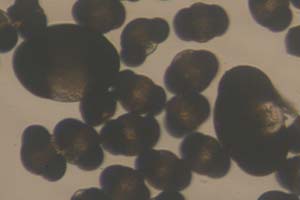
Pollen from
Pinus mugo, mugo pine - about 60-65 µm
Pollen from
Picea, spruce - about 115 µm
Pollen: Pinopsida – conifers
Latin pinus, pine
Conifers are common trees and shrubs. The pollen are carried by wind, and in some kinds they have two distinctive sacca or vesicles to help keep them aloft or upright.
Two such kinds are pine and spruce. Pollen of the former are relatively small, while those of the latter have sacca that are more continuous with the main body.
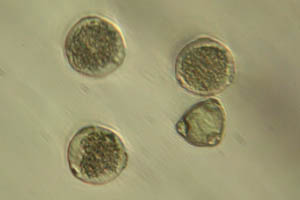
Pollen from
Betula, birch - about 25-30 µm
Pollen: Angiospermae – flowering plants
Greek aggeion, vessel, sperma, seed
Angiosperms include the main diversity of seed plants. Pollen here are often sticky, though less so when carried by wind, and some have multiple apertures, chiefly among eudicots.
Eudicots typically have pollen with openings spaced around an equator, most often three in number. These vary from furrows to pores in different groups.
